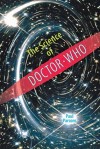 The Plot
The Plot
Over the course of its long history, the science fiction series Doctor Who has presented any number of intriguing inventions, devices, technological advances and alien species. Scientist (and journalist) Paul Parsons takes a critical look at the TARDIS, the sonic screwdriver, the Cybermen and more and attempts to discover whether any of these things are actually plausible given what is currently known of physics and biology.
My Thoughts
Several years ago, I ran across a book titled The Physics of Star Trek. As a fan of Star Trek and of physics, it was obviously a required purchase, and so I did. The book took a close look at many of the technologies invented for the Star Trek universe — warp drive, transporters, holodecks, phasers and photon torpedoes — and evaluated their scientific plausibility based upon our current knowledge of physics and the universe. It was written at about the same level as Stephen Hawking’s A Brief History of Time, which is to say requiring thought but not out of reach to the average reader.
There soon grew up a small industry around these types of books, as The Physics of Star Trek was followed by The Science of Star Wars, the Physics of Superheroes, The Science of Supervillains, the Physics of Christmas, The Science of Harry Potter — the list goes on. Inevitably (and yet, surprisingly late) the publishing forces landed upon Doctor Who and soon The Science of Doctor Who arrived.
As is perhaps understandable, given Parsons’ background as a science magazine editor, the book reads more as a series of separate articles than as a continuous whole. In all there are 35 different feature length essays, each focusing on a different point of the Whoiverse and bringing in information from scientific experts and science research to either support or discredit the possibility of that particular item/alien/ability ever being a reality.
The articles themselves are quite breezy and informative, definitely meant for the layperson without being excessively dumbed down. Understandably, some of the scientific explanations overlap considerably with those necessary for other series (black holes, wormholes, faster than light travel — those are pretty much science fiction staples at this point) but Parsons tries to put his own spin on them.
The main issue I ended up having with the book was that it was monotonous in its set-up. I think it would have worked a lot better as a monthly series in a magazine than it does collected in a book, because the structure of each chapter (aka article) is essentially the same: Parsons describes some element from the Whoiverse, such as an alien species, and mentions a few episodes in which they appeared. He poses a question about their existence or development, then brings in the opinions of one of the expert scientists, summarizing their findings. All of this takes 7-10 pages and then the article ends; on to the next topic. Though the articles themselves are loosely collected into ‘sections’ there’s no actual narrative thread that connects the parts of the section together; they could just as easily have been in a different order entirely.
The monotony might also have been alleviated somewhat had the stable of consulting scientists been larger. Or perhaps if the consulting sections had been woven together, it wouldn’t have been as obvious that the same person was being spoken to about multiple topics. Ditto the actual episodes which were referenced: while I’m sure Parsons did survey the whole of the Who canon before writing the book, there were several episodes of the series which were mentioned a lot. A lot.
Apart from my issues with how the book was organized, Parsons did a fine job selecting a wide variety of topics for coverage. A smattering of tech, of temporal and spatial phenomena, of alien beings: something for everyone. I can’t really complain at the choices, though I do think some of the science involved in thinking through the aliens was a wee bit thin. Also, if this book was really updated for the U.S. release, there should definitely have been a chapter about the Ood.
In Short
While I won’t go so far as to call this book a must read for any Doctor Who fan, it was definitely entertaining. I have no reason to question any of the scientific conclusions presented either. But I did feel like the information presented was a bit shallow, not just because so many different topics were covered, but because the coverage was so discrete. It was also noticeable by the end that certain ‘favorite’ episodes were referenced constantly rather than using a wider breadth of the series as source material. Additionally, though this version claims to have been updated for the U.S. release, it’s not really – Ten and Eleven are pretty much completely absent from its pages.


